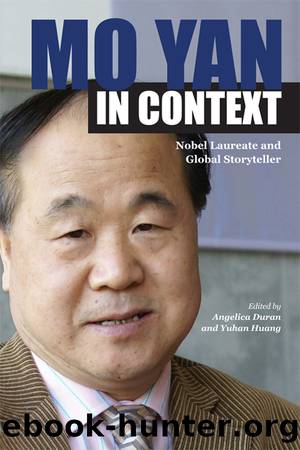Mo Yan in Context by Duran Angelica;Huang Yuhan;

Author:Duran, Angelica;Huang, Yuhan;
Language: eng
Format: epub
Publisher: Purdue University Press
Figure 1. (Art Comes from the Life of Struggle, and Working People are the Masters), 1970s. From the personal e-library of Yuhan Huang per the Chinese Posters Foundation, Amsterdam.
As politicized as poster art is, it is a widely held misbelief that poster artists during the Cultural Revolution period cared little about the artistic merits of their work. Poster art served primarily as a popular form of propaganda, but it also evolved into a serious artistic genre in Chinese art history. It became a common practice during the Cultural Revolution for poster artists to combine several kinds of painting techniques, including oil painting, printmaking, woodcut, as well as Chinese traditional painting. Their aesthetics was intertwined with their political beliefs, and the employment of painting was invested with equal importance to the activities of military heroes. The collectivity of the authorship of poster art is of signal importance to its aesthetics and politics. As a whole, poster artists are anonymous rather than individually recognized. Most posters from the Cultural Revolution are unsigned to emphasize the collective nature of artistic creation: art should not be created for individual recognition but for serving and educating the masses.
With artistic talent viewed as a convenient tool to carry out ideological instruction, the public bulletin board became another venue for political struggle, as Mo Yan reflects in Life and Death. In one scene, Jinlong makes use of the bulletin board to satirize Lan and his blue-faced son Jiefang as the only independent household, separate from the peopleâs commune. Jinlong creates a âvisual feastâ with images of tractors, sunflowers, and commune members plowing the field, in contrast to the independent household members, skinny and unhappy: bright colors of red and yellow contrast against sullen colors of blue and white. Villagers gather to appreciate the painting and read its subtitles, denouncing collectively the socially unfit, âthe villageâs obstinate independent farmer Lan Lian and his family, who works on his land with a single ox and plow, the ox with its head lowered, the farmer looking crestfallen, a solitary figure looking like a plucked chicken, his ox like a stray dog, miserable and anxious, having coming to a dead endâ (149). Jinlongâs work does not really accurately depict the true situation, in which the blue-faced family is in high spirits and their ox young and vigorous. While the young Lan protests his dissatisfaction with the political message, the father articulates an aesthetic evaluation: âThat boy has talent. Whatever he draws looks realâ (149). This scene shows that with this genre of art, it is more important to look real rather than to be real to achieve its political purpose. Although the bulletin board serves as the center for public opinion and aims to provide one unified voice for the masses to understand and learn from, Lan shows another level of interpretation.
One of the most famous images of Chairman Mao in the Cultural Revolution is Liu Chunhuaâs 1967 oil painting (Chairman Mao Goes to Anyuan) (see figure 2). It is one of the few instances in which the artist is acknowledged, yet with a twist.
Download
This site does not store any files on its server. We only index and link to content provided by other sites. Please contact the content providers to delete copyright contents if any and email us, we'll remove relevant links or contents immediately.
4 3 2 1: A Novel by Paul Auster(11788)
The handmaid's tale by Margaret Atwood(7447)
Giovanni's Room by James Baldwin(6808)
Asking the Right Questions: A Guide to Critical Thinking by M. Neil Browne & Stuart M. Keeley(5355)
Big Magic: Creative Living Beyond Fear by Elizabeth Gilbert(5351)
Ego Is the Enemy by Ryan Holiday(4956)
On Writing A Memoir of the Craft by Stephen King(4662)
The Body: A Guide for Occupants by Bill Bryson(4580)
Ken Follett - World without end by Ken Follett(4443)
Bluets by Maggie Nelson(4260)
Adulting by Kelly Williams Brown(4232)
Eat That Frog! by Brian Tracy(4149)
Guilty Pleasures by Laurell K Hamilton(4116)
White Noise - A Novel by Don DeLillo(3829)
The Poetry of Pablo Neruda by Pablo Neruda(3813)
Fingerprints of the Gods by Graham Hancock(3733)
Alive: The Story of the Andes Survivors by Piers Paul Read(3729)
The Book of Joy by Dalai Lama(3695)
The Bookshop by Penelope Fitzgerald(3619)
